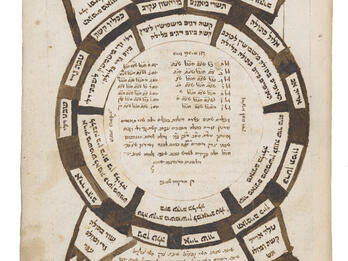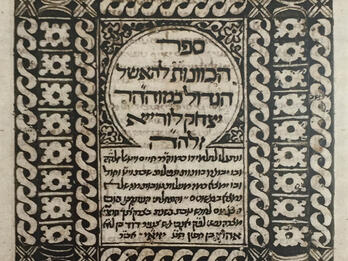Tsadik yesod ‘olam (The Righteous Is an Everlasting Foundation)
And so it was in the days of the Judge of judges; and so it was, a famine in the land. And a man went out from Bethlehem in Judah to live in the field of Moab, he and his wife and his two sons. (Ruth 1:1)
It is already known that the kabbalists wrote that before the creation of the worlds, the sefirot1 were concealed within His essence, may He be blessed; and Ein Sof, may He be blessed, assumed every level that was concealed within Him. And behold, the attribute of keter [“crown”; the first sefirah], which was concealed within Him, could be attributed to Him even though He was not yet ruling over anything besides Himself. The same is true of ḥokhmah [“wisdom; the second sefirah], and binah [“understanding”; the third sefirah], and indeed with all of the sefirot. Thus, when He, may He be blessed, had assumed the attributes within His essence he did not have to create the worlds.
This was not the case when the will of the Lord, may He be blessed, began to be aroused and to assume within its essence the trait of malkhut [“kingdom”; the tenth sefirah] which was concealed within Him, may He be blessed. At that point, the will of the Lord, may He be blessed, saw that the attribute of malkhut was not possible as an attribute unless it were ruling and governing over something else. For this reason, the creation of worlds was necessary in place of the level of malkhut within His essence.
It turns out that [besides malkhut,] every level that was concealed within Him could be attributed to Him, even without His ruling over that which is other than Him. And each and every level that was concealed within Him had the same attribute before creation as it has now after creation. However, there was no division, and it was all only concealed within Him. Thus, every concealed level had an attribute of judgment, which is malkhut, the “kingship” of God, and He, may He be blessed, was the Judge of judges, in that everything was concealed within Him. However, the attribute of the trait of malkhut that was concealed within Him, may He be blessed, could not be attributed to Him prior to the creation. And the glory of the Lord, may He be blessed, was not complete in regard to all of the attributes. This is the meaning of the verse: And so it was in the days of the Judge of judges. The phrase and so it was invariably indicates some type of distress. What was the distress here? Scripture explains: And so it was, a famine in the land. It is known that the word land refers to malkhut. That is to say, He, may He be blessed, assumed the trait of malkhut, which is the land, within His essence, and so it was, a famine, that is, it was not possible for it to be attributed to Him, since there can be no king without a people. This is the meaning of the fact that the actions recounted within the book of Ruth took place before the rule of a king, before creation, during the time at which God assumed all of the concealed levels within His essence; and each one had its own attribute, and He was the Judge of judges. But in regard to the land, which is malkhut, there was a famine for the glory of the Lord, may He be blessed. According to this, the phrase and so it was signifies sorrow and lack. [ . . . ]
The phrase and a man went means that when He assumed the trait of malkhut in His essence, He was already compelled to create worlds. [ . . . ] And a man went teaches about the drawing down of the will; man is as it is written: The Lord is a man of war (Exodus 15:3), for immediately after He began to emanate and to draw down His will, the Holy Name was made known by way of the secret of the thought that is holy to the Lord. This is within the keter that is within the keter, the crown within the crown. And man is the tif’eret [“beauty”; the seventh sefirah] that is within the keter that is within the keter. And the tif’eret that is within the keter that is within the keter encompasses within itself all of the levels that are within the keter that is within the keter. According to this, we say that man is the tif’eret that is within the keter that is within the keter, and the Tetragrammaton is within tif’eret, which contains everything.
Notes
[According to Lurianic kabbalah, each sefirah contains within itself all of the sefirot, in an infinite regress. Thus, for example, keter contains within itself keter, which contains within itself tif’eret, etc.—Trans.]
Credits
Isaac Luria (attrib.), “Tsadik yesod ‘olam (The Righteous Is an Everlasting Foundation)” (manuscript, 16th century). Published in: Ḥayyim ben Joseph Vital, Shaʻar ha-yiḥudim (Korets: Yahon Anton Kriger, 1783), pp. 41a–43a.
Published in: The Posen Library of Jewish Culture and Civilization, vol. 5.




